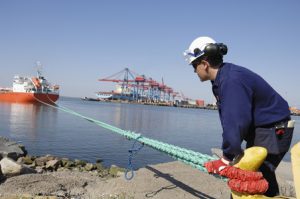[breadcrumb]
 How Can a Longshoreman Get Mesothelioma by Occupational Exposure to Asbestos?
How Can a Longshoreman Get Mesothelioma by Occupational Exposure to Asbestos?
Longshoremen work in harbors and commercial ports and load and unload cargo to and from vessels. They also sort and distribute cargo for shipping and processing. They may also synchronize their efforts with warehouses and other companies that assist in the transportation of cargo.
Longshoremen often moved products to and from various locations throughout the ship where asbestos may have been exposed. They may have worked around other workers who came in contact with asbestos and developed secondhand asbestos exposure from contact with these workers. They were often exposed to asbestos when handling asbestos-containing insulation and fireproofing materials. Before the 1980s, longshoremen often loaded bundles of raw asbestos fibers that were sent from around the nation. Often, these workers were not aware of dangers associated with these products and did not take any precautions to guide against the dangers, which further heightened their risk of developing mesothelioma and other asbestos-related diseases.
Common duties of longshoremen include:
- Move large cargo containers
- Unload cargo and organize them on ships
- Follow vessel loading plans and instructions
- Prepare cargo for lifting
- Load cargo on trucks
- Unload cargo on trucks
- Stack cargo on ships and other vessels
- Secure cargo on vessels
- Operate loading equipment such as cranes and forklifts
- Operate handtools
- Notify supervisor of damaged or hazardous cargo
Locations in the United States for the Highest Employment Rates for Longshoremen
Approximately 3.9 million people were employed as longshoremen in 2016. The industry is expected to grow to 4.2 million people by 2026. Most longshoremen work in coastal states.
Similar Occupations as Longshoremen
Similar occupations as longshoremen include the following:
- Construction laborers and helpers
- Delivery truck drivers
- Freight workers
- Hand laborers and material movers
- Heavy and tractor trailer truck drivers
- Material moving machine operators
- Material recording clerks
- Water transportation workers
Lawsuits and Settlements Involving Longshoremen and Mesothelioma
There have been a few notable asbestos verdicts in favor of former longshoremen who were exposed to asbestos and their families. In 2017, a San Francisco jury awarded $24.26 million to a retired longshoreman who worked as a longshoreman laborer and clerk from 1959 to 2001 in many San Francisco Bay Area piers. He would load and unload cargo at these jobsites and would take breaks in the ship engine rooms that were insulated with asbestos-containing insulation and where workers handled asbestos-containing gaskets and packing. The lawsuit was filed against Triple A Machine Shop, Inc., a shipyard contractor that conducted work on the ships and failed to warn the plaintiff of the dangers of its products even though it knew or should have known about these dangers. The man died one day after the verdict was rendered.
In 2019, a longshoreman who worked on the New Orleans Riverfront was awarded $3 million for the man’s past and future medical expenses, loss of enjoyment of life, emotional trauma and pain and suffering after the man was diagnosed with mesothelioma due to occupational exposure to asbestos.
Studies Related to Longshoremen and Asbestos
A few studies have explored asbestos exposure in ships. The U.S. National Institutes of Health conducted a study in 2008 called “Asbestos and Ship-Building: Fatal Consequences.” In this study, in researchers concluded that shipfitters were 16 times more likely to be diagnosed with an asbestos-related disease than people employed in other occupations. Longshoremen may have been exposed to some of the same types of materials that shipfitters were.
A 1980 medical study followed workers with 20 or more years of experienced in ship repair and found that 86% developed asbestos-related lung cancer. Those who work on renovating asbestos-containing ships or move damaged asbestos in shipyards continue to be at risk.
Types of Asbestos Products Used by Longshoremen
Longshoremen moved cargo to and from nearly every part of the ship, so they could have been exposed to asbestos materials found in:
- Insulation
- Fireproofing materials
- Boilers
- Steam pipes
- Turbines
- Pipe covering
- Gaskets
- Pumps
- Cement
- Packing
- Tape
Manufacturers of Products Used by Longshoremen
Longshoremen who worked in any of the following shipyards may have been exposed to asbestos:
- Alabama Dry Dock
- Albina Shipyard
- Barbours Cut Docks
- Bethlehem Steel Shipyard
- Bremerton Naval Shipyard
- Brooklyn Navy Yard
- Caddell Dry Dock
- California Navy Shipyard
- Charleston Naval Shipyard
- Consolidated Steel Shipyards
- Curtis Bay Coast Guard Yard
- Defoe Shipyard
- Duwamish Shipyard
- Galveston Docks
- General Dynamics NASSCO
- GMD Shipyard
- Groton Naval Base
- Houston Shipyards
- Hunters Point Naval Shipyard
- Ingalls Shipbuilding
- Kane Shipbuilding
- Kaiser Shipyard
- Lockheed Shipyard
- Long Beach Naval Shipyard
- Moore Dry Dock
- Naval Station Everett
- Naval Weapons Station
- New York Shipbuilding Corporation
- Newport News Naval Shipyard
- Norfolk Naval Shipyard
- Orange Shipbuilding
- Pearl Harbor Shipyard
- Pensacola Naval Air Station
- Portsmouth Naval Shipyard
- San Diego Naval Shipyard
- San Francisco Drydock
- Seward Ships Drydock
- Sun Shipbuilding
- Tacoma Drydock
- Todd Shipyards
- Washington Navy Yard
- Willamette Iron and Steel Works
